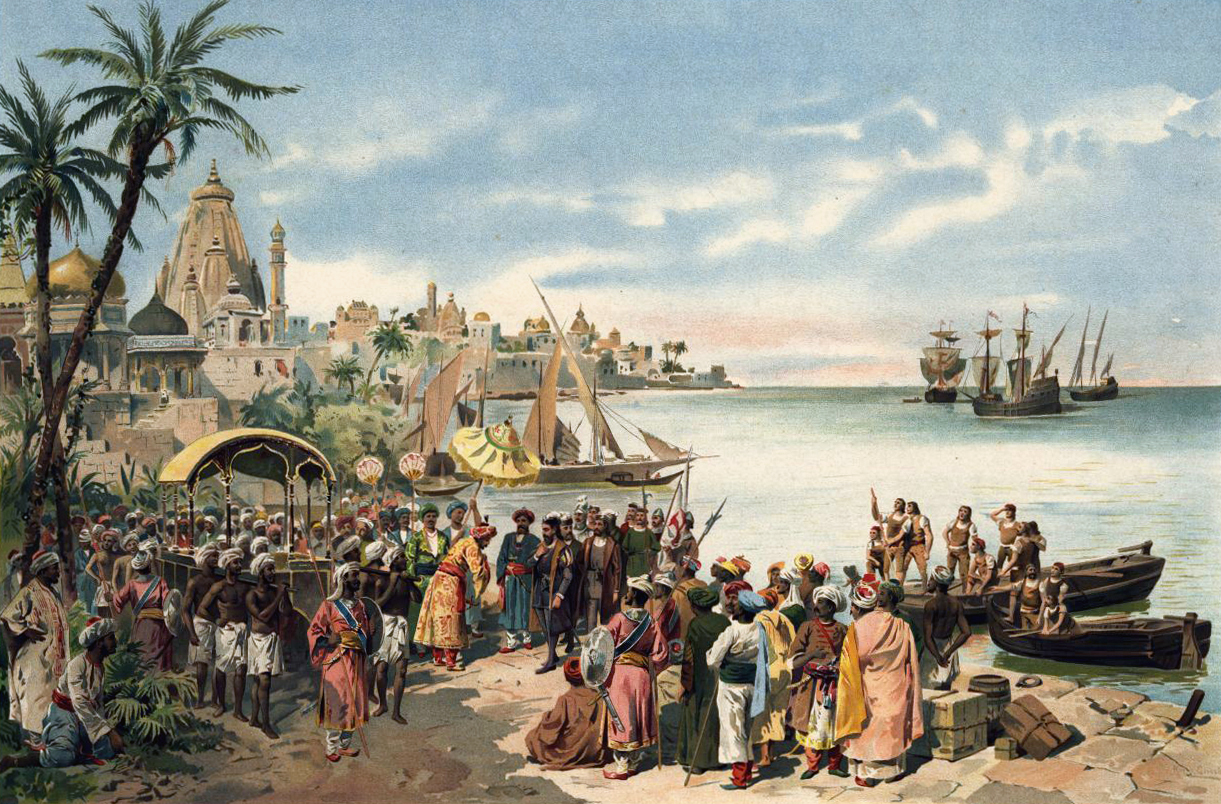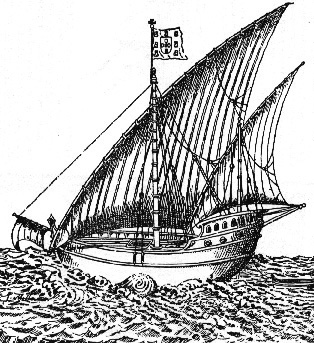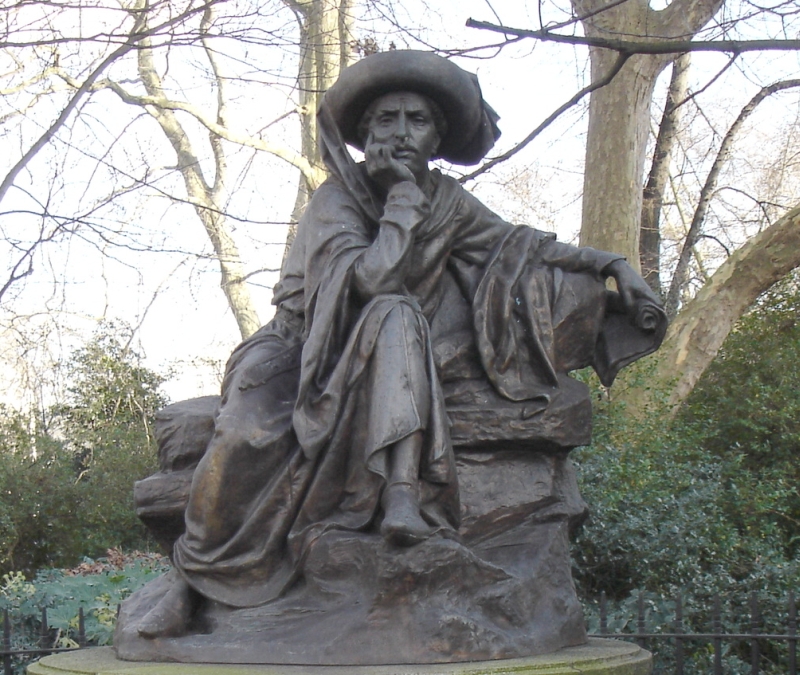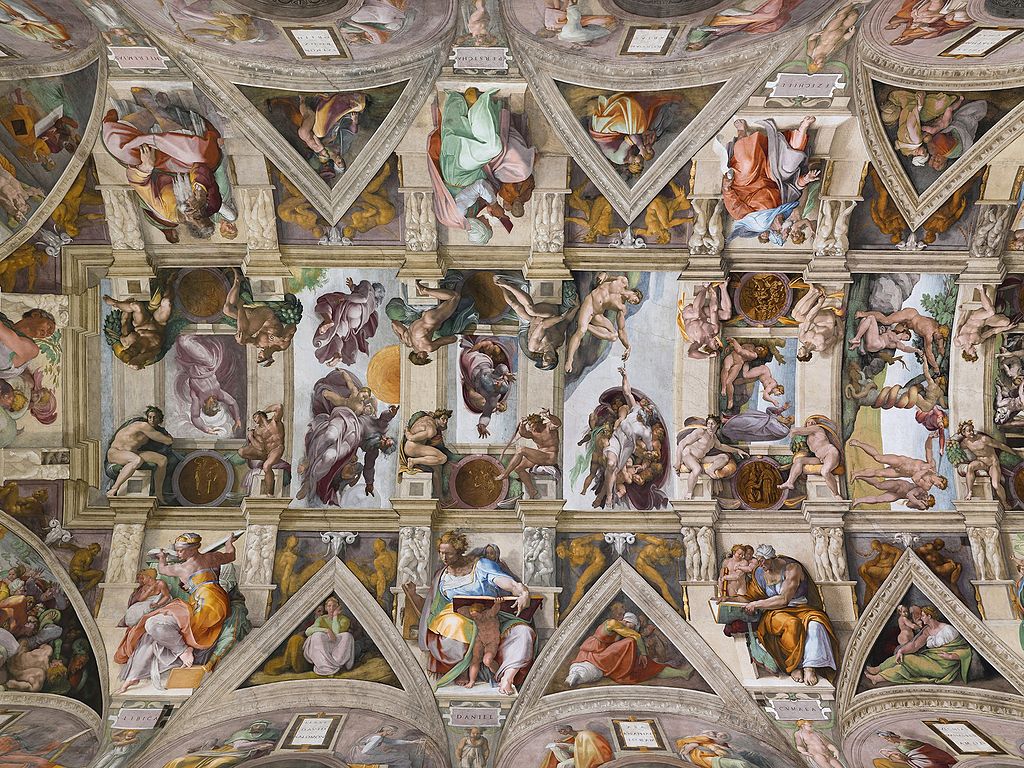Globalizing Networks of Communication and Exchange (1450-1750 CE)
 |
| Vasco da Gama in India by Alfredo Roque Gamerio (1900) |
Topics on this page
I. Intensification of all existing regional trade networks
II. Production of new tools, innovations in ship designs and an improved understanding of global wind and current patterns, all of which made transoceanic travel and trade possible.
III. Remarkable new transoceanic maritime reconnaissance occurred in this period.
IV. Regional markets continued to flourish in Afro-Eurasia using established commercial practices and new transoceanic shipping services developed by European merchants.
Trade between Europe and East Asia began to widely open. At first, China and India had more economic power than Europe. As European empires grew both in wealth and size, the trade deficit turned in favor of Europe due to wealth accumulated in the new world. (Cash crops, silver, etc.)
V. The new connections between the Eastern and Western hemispheres resulted in the Columbian Exchange.
VI. The increase in interactions between newly connected hemispheres and intensification of connections within hemispheres expanded the spread and reform of existing religions and created syncretic belief systems and practices.
VII. As merchants' profits increased and governments collected more taxes, funding for the visual and performing arts, even for popular audiences, increased.
 See also, United States History Transatlantic Encounters.
See also, United States History Transatlantic Encounters.
 Timeline detailing the development and connection between the 'Old World' and the 'New World' from 5000 BCE to 1808.
Timeline detailing the development and connection between the 'Old World' and the 'New World' from 5000 BCE to 1808.
I. In the context of the new global circulation of goods, there was an intensification of all existing regional trade networks that brought prosperity and economic disruption to the merchants and governments in the trading regions of the Indian Ocean, Mediterranean, Sahara, and overland Eurasia.
For information on maritime trade after 1500, see Web of Connections from the Smithsonian website, On the Water.
Book Recommendations:
- Empires of Food: Feast, Famine and the Rise and Fall of Civilizations. Evan D. Fraser & Andrew Rimas, 2010.
- Salt: A World History, Mark Kurlansky, 2003.
- Banana: The Fate of the Fruit that Changed the World, Dan Koeppel, 2008.
- Cod: A Biography of the Fish That Changed the World. Mark Kurlansky, 1998
- Spice: The History of a Temptation, Jack Turner, 2005
- A Brief History of the World in 6 Glasses, Tom Standage, 2006.
- Uncommon Grounds: The History of Coffee and How It Transformed Our World, Mark Pendergrast, 2010.
Become a Spice Trader, a learning game from Annenberg Learner
II. European technological developments in cartography and navigation built on previous knowledge developed in the classical, Islamic and Asian worlds, and included the production of new tools, innovations in ship designs and an improved understanding of global wind and current patterns, all of which made transoceanic travel and trade possible.
[Teach one illustrative example of new tools, either from the list below or an example of your choice: Astrolabe, Revised maps.]
The Astrolabe- The astrolabe has been dubbed by some as the first "laptop computer."
- With its origins tracing back to Ancient Greece, the astrolabe could determine the latitude and longitude of one's location, determine where and when the sun would rise, be able to tell the time and date, in addition to many other uses.
- With the rise of the Islamic Empire the astrolabe made its way to Asia, India, and eventually Europe.
- The astrolabe, and its instructions, spread through Europe thanks to Gerbert of Aurillac (Pope Sylvester II), who made contact with Muslim traders in Spain in the late 10th century.
- Gerbert made members of his monastery learn how to operate an astrolabe, a practice other monasteries soon picked up.
How does the astrolabe work? This TED talk shows how the astrolabe was used to tell time at night.
Click here for background on the history of the compass.
[Teach one illustrative example of innovations in ship designs, either the one below or an example of your choice: Caravels.]

The Caravel- What started as a ship used by Iberian fisherman in the 13th century, the caravel would become the preferred ship for European expeditions to the New World and around Africa to India and Asia.
- The caravel transformed sea travel and trade in numerous ways.
- One way was the use of a triangular sail, called lateen-rigging. This allowed ships to sail into the wind, as well as with the wind.
- In addition to the sails, the caravels were highly maneuverable. This allowed sailors to get close to shore, and be able to stay away from dangerous shoals.
- Thirdly, the caravel had an ideal balance in terms of its weight. It was light enough to travel quickly, yet had enough tonnage to be able to carry large amounts of fresh water for longer voyages.
- The Nina and the Pinta, two of Columbus' three ships on his 1492 voyage were caravels.
- Vasco de Gama also used the caravel on his journeys to Africa and India.
 Timeline for the Scientific Revolution
Timeline for the Scientific Revolution
For more on the Scientific Revolution
III. Remarkable new transoceanic maritime reconnaissance occurred in this period.
Statue of Zheng He, Nanjing, China

A. Official Chinese maritime activity expanded into the Indian Ocean region with the naval voyages led by Ming Admiral Zheng He, which enhanced Chinese prestige.
Zheng He's Voyages of Discovery from UCLA International Institute explores the 15th century expeditions of the Chinese mariner and the celebration of the 600th anniversary of his first voyage.
The links on this page show Zheng He's voyages.
A one minute video from the Wall Street Journal with a quick history of Zheng He and the implications he has today.
See Political and Cultural Aspects of Chinese Civilization to 1800
 |
| Statue Of Prince Henry The Navigator-Belgrave Square London |
B. Portuguese development of a school for navigation led to increased travel to and trade with West Africa, and resulted in the construction of a global trading-post empire.
For more background, see Portugal Leads the Way from the Watertown, Massachusetts Public Schools.
Go here for a biography of Prince Henry the Navigator
C. Spanish sponsorship of the first Columbian and subsequent voyages across the Atlantic and Pacific dramatically increased European interest in transoceanic travel and trade.
Here is also a great Primary Source from Christopher Columbus that also can be used in lessons: Columbus Primary Source Exercise.
CCOT: Change and Continuity Essay prompt 2005: Analyze the social and economic transformations that occurred in the Atlantic world as a result of new contacts among Western Europe, Africa, and the Americas from 1492 to 1750.
Student Samples Scoring Guidelines
D. Northern Atlantic crossings for fishing and settlements continued and spurred European searches for multiple routes to Asia.
E. In Oceania and Polynesia, established exchange and communication networks were not dramatically affected because of infrequent European reconnaissance in the Pacific Ocean.
Flag of the British East India Company, 1707–1801

IV. The new global circulation of goods was facilitated by royal chartered European monopoly companies who took silver from Spanish colonies in the Americas to purchase Asian goods for the Atlantic markets, but regional markets continued to flourish in Afro-Eurasia using established commercial practices and new transoceanic shipping services developed by European merchants.
A. European merchants' role in Asian trade was characterized mostly by transporting goods from one Asian country to another market in Asia or the Indian Ocean region.
Instead of interfering with Asian trade systems, European merchants integrated themselves into existing trade networks.
Dramatic Event Page: The British East India Company
B. Commercialization and the creation of a global economy were intimately connected to new global circulation of silver from the Americas.
A good overview of the impact of silver on world trade can be seen in this short Crash Course World History video.
Slideshow with maps showing the evolution of the world silver trade from 1500 - 1800.
In the 1400s, most of the silver imported into China came from Japan. From 1500 to 1800, Mexico and Peru produced something like 85 percent of the world's silver. During that same period at least a third and some people would say over 40 percent of all that silver eventually wound up in China.
More on how Chinese demand for silver drove the silver trade can be read here.
Potosi, Silver Mining and the Silver Trade
- Central to the global silver trade were the extensive silver mines of the mountain of Potosí (in the highlands of contemporary Bolivia, at an altitude of 4,800 meters).
- These proved among the most important sources of wealth in all of Spain’s New World holdings, fleetingly filling the coffers of the Spanish treasury for more than two centuries while relegating thousands of Indian laborers to a hellish work existence.
- Silver ore was serendipitously discovered at Potosí by an Indian yanacona (servant) named Diego Gualpa in 1545.
- Within a few years there had commenced a vast silver rush, which peaked in the 1590s, after which silver production underwent a gradual decline, though the mines continued to be worked throughout the colonial period.
- In 1545, the population of Potosí and its environs stood at around 3,000. Thirty-five years later, in 1580, the numbers had swelled to around 120,000, and by 1650 to around 160,000, making the remote mining center one of the largest urban concentrations in the world.
The major work on the silver trade has been done by Dennis Flynn and Arturo Giraldez, both of the University of the Pacific. This work has been collected in China and the Birth of Globalization in the 16th Century (Ashgate Variorum, 2010), but is also available on-line, like "Born with a "Silver Spoon": The Origin of World Trade in 1571" and "Cycles of Silver: Global Economic Unity Through the Mid-Eighteenth Century".
The silver DBQ from the 2006 AP test and the annotated silver DBQ created by Angela Lee and Bill Strickland are useful teaching lessons.
[Using the documents, analyze the social and economic effects of the global flow of silver from the mid-sixteenth century to the early eighteenth century. Explain how another type of document would help you analyze the effects of the flow of silver bullion in this period.
Historical Background: Spanish colonial America and Tokugawa Japan led the world in silver production from 1500 to 1750. In the early 1570's, the Ming Chinese government required that all domestic taxes and trade fees be paid in silver.
(Also included was a map entitled “The Primary Flow of Silver, 1570-1750)]
Maggie Favretti's award winning lesson, "Bound By a Silver Chain: 1571" that appeared in the Fall 2006 World History Bulletin usefully illustrates why global silver trade was so important to this era and how it changed over time.
C. Influenced by mercantilism, joint-stock companies were new methods used by European rulers to control their domestic and colonial economies and by European merchants to compete against one another in global trade.
Background on the British East India Company
D. The Atlantic system involved the movement of goods, wealth, and free and enslaved laborers, and the mixing of African, American, and European cultures and peoples.
CCOT: Change and Continuity Essay prompt 2005: Analyze the social and economic transformations that occurred in the Atlantic world as a result of new contacts among Western Europe, Africa, and the Americas from 1492 to 1750.
V. The new connections between the Eastern and Western hemispheres resulted in the Columbian exchange.
During the time global trade resulted in the spread of many different goods. In particular food between the Americas and the rest of the world was a major commodity of the time.
One of the best examples of this would be through the trading of potatoes. Potatoes became such an important part of the Irish diet that when the potato blight hit in the mid 19th century, up to one million Irish men died to a lack of other food staples at the time (1).
Here is another link showing how important corn was at the time, and how important it still is today: The Corn Trade.
Food was not the only thing passed between traders.
- Many European settlers brought with them diseases to the Americas where Native Americans had little resistance to them. Because Europeans lived in close proximity to domesticated animals due to their high value, they developed an immunity to small pox which was transferred from those animals. People in the Americas were not exposed due to this cultural difference, and as such became infected. The development of small pox and other diseases allowed for the Europeans to more easily colonize the Americas, a tool of major importance in developing the Colombian exchange (2).
The Columbian Exchange, Crash Course video.
Here is a great sample lesson plan to used in teaching about the Columbian Exchange: Lesson Plan.
Here is also a great Primary Source from Christopher Columbus that also can be used in lessons: Columbus Primary Source Exercise
The term Columbian exchange comes from Alfred Crosby's book of the same name: The Columbian Exchange: Biological and Cultural Consequences of 1492 (Westport, CT: Praeger, 1972, revised, 2003).
- Crosby later amplified this work with Ecological Imperialism: The Biological Expansion of Europe 900-1900 (Cambridge University Press, 1993)
- He has continued to write about the exchange in various publications, including a short article in History Now. The most recent major work updating Crosby's central thesis is Charles Mann's 1493: Uncovering the New World Columbus Created (New York: Knopf, 2011).
For the quincentenary of the Columbus's landfall in the Americas the Smithsonian put on a useful exhibition and created an excellent publication, with help from the National Council of the Social Studies on aspects of the Columbian Exchange, called Seeds of Change.
The Columbian exchange was a large scale trade operation between the continents of Europe, Africa and the Americas. This transfer of plants, animals, ideas and people brought changed these continents lifestyles and cultures in major ways. Places known for 'staples' such as Italy and tomato sauce wouldn't have ever occurred without this trade.
The following map shows what was exchanged in the Columbian Exchange:
 Here is a lesson plan from PBS on the Columbian Exchange.
Here is a lesson plan from PBS on the Columbian Exchange.
For more about the Columbian Exchange
A. European colonization of the Americas led to the spread of diseases — including smallpox, measles, and influenza — that were endemic in the Eastern Hemisphere among Amerindian populations and the unintentional transfer of vermin, including mosquitoes and rats.
 For a interactive look at this topic, go to Disease and Catastrophe from North Carolina Digital History.
For a interactive look at this topic, go to Disease and Catastrophe from North Carolina Digital History.
B. American foods became staple crops in various parts of Europe, Asia, and Africa. Cash crops were grown primarily on plantations with coerced labor and were exported mostly to Europe and the Middle East in this period.
[Teach one illustrative example of American foods, either from the list below or an example of your choice: Potatoes, Maize, Manioc]
[Teach one illustrative example of cash crops, either from the list below or an example of your choice: Sugar, Tobacco]
C. Afro-Eurasian fruit trees, grains, sugar, and domesticated animals were brought by Europeans to the Americas, while other foods were brought by African slaves.
The Colombian Exchange introduced new animals to the Americas, Europe, and Africa! The new organisms brought by Europeans often competed with the indigenous species which were often overwhelmed by the incoming flora and fauna. Native people often adapted ad benefited from the introduction of species.
[Teach one illustrative example of domesticated animals, either from the list below or an example of your choice: Horses,
Pigs, Cattle]
[Teach one illustrative example of foods brought by African slaves, either from the list below or an example of your choice: Okra, Rice]
For more, see The Atlantic Slave Trade from the African Studies Center at Michigan State University.
See also Dramatic Event Page on Origins of the Atlantic Slave Trade
D. Populations in Afro-Eurasia benefited nutritionally from the increased diversity of American food crops.
E. European colonization and the introduction of European agriculture and settlements practices in the Americas often affected the physical environment through deforestation and soil depletion.
VI. The increase in interactions between newly connected hemispheres and intensification of connections within hemispheres expanded the spread and reform of existing religions and created syncretic belief systems and practices.
A. As Islam spread to new settings in Afro-Eurasia, believers adapted it to local cultural practices. The split between the Sunni and Shi'a traditions of Islam intensified, and Sufi practices became more widespread.
2003 Change & Continuity Essay (Be sure to discuss continuities as well as changes): Describe and Analyze the cultural, economic, and political impact of Islam on ONE of the following regions between 1000 CE and 1750 CE: West Africa or South Asia or Europe Student Samples Scoring Guidelines
B. The practice of Christianity continued to spread throughout the world and was increasingly diversified by the process of diffusion and the Reformation.
In the new world, Christianity mingled with existing new world beliefs as well as indigenous African beliefs. Latin American missions were set back by worship of old idols by the natives. Christianity and African religions mingled to create a new Christianity-Voodoo hybrid.
Read about Isabella funding Columbus to spread Christianity and the debate whether to make her a saint from the New York Times.
Map Key for European colonization 1674: Blue=French; Red=English; Green=Dutch; Purple=Spanish; Yellow and Light Green=Iroquois

 For background in the Protestant Reformation, see Lesson One: Turning Points from Martin Luther:The Reluctant Revolutionary from PBS.
For background in the Protestant Reformation, see Lesson One: Turning Points from Martin Luther:The Reluctant Revolutionary from PBS.
C. Buddhism spread within Asia.
See more about the spread of Buddhism at Key Concepts 2.1.
Link to page about Buddhism
D. Syncretic and new forms of religion developed.
[Teach one illustrative example of syncretic and new forms of religion, either from the list below or an example of your choice: Vodun in the Caribbean, The cults of saints in Latin America, Sikhism in South Asia].
VII. As merchants' profits increased and governments collected more taxes, funding for the visual and performing arts, even for popular audiences, increased.
A. Innovations in visual and performing arts were seen all over the world.
[Teach one illustrative example of innovations in visual and performing arts, either from the list that follows or an example of your choice: Renaissance art in Europe, Miniature paintings in the Middle East and South Asia, Wood-block prints in Japan, Post-conquest codices in Mesoamerica].

This link shows how art expanded in Europe at the time through the painting of the Sistine Chapel Sistine Chapel.
Link here for more about the Sistine Chapel and background on the Renaissance.
B. Literacy expanded and was accompanied by the proliferation of popular authors, literary forms, and works of literature in Afro-Eurasia.
[Teach one illustrative example of popular authors, literary forms and works of literature, either from the list that follows or an example of your choice: Shakespeare, Cervantes, Sundiata, Journey to the West, Kabuki]
CROSS-LINKS:
Influential Literature page on Haikus and One Breath Poems
- Here is a video of Kabuki, Japanese theater
Shakespeare's play Julius Caesar, resources for teaching Shakespeare, and women as actors in plays
Jeopardy-style game to review AP World History Unit 4
Sources:
1) http://www.biology.ed.ac.uk/research/groups/jdeacon/microbes/blight.htm
2) http://www.pbs.org/gunsgermssteel/variables/smallpox.html
3) http://www.pachs.net/images/uploads/blog_uploads/Astrolabes.pdf
4) http://nautarch.tamu.edu/shiplab/01George/index.htm
5) http://commons.wikimedia.org/wiki/File:Slave_ship_diagram.png
Comments (0)
You don't have permission to comment on this page.